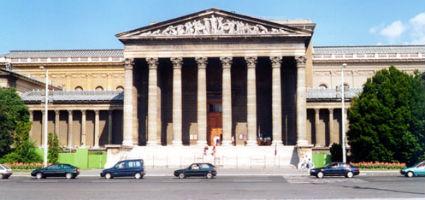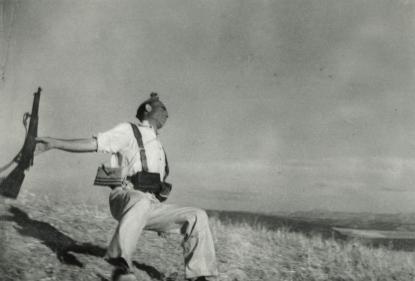2024. April 26. Friday
Budapest Museum of Fine Arts - Budapest
 |
Address: 1146, Budapest Dózsa György út 41.
Phone number: (1) 469-7100
E-mail: info@szepmuveszeti.hu
Opening hours: Tue-Sun 10:00-18:00
|
The exhibition has closed for visitors.
2008.06.05. - 2008.09.21.
Museum tickets, service costs:
|
Ticket for adults
(valid for the permanent exhibitions)
|
2800 HUF
|
/ capita
|
|
Ticket for adults
|
3200 HUF
|
|
|
Group ticket for adults
|
2900 HUF
|
|
|
Ticket for students
(valid for the permanent exhibitions)
|
1400 HUF
|
/ capita
|
|
Ticket for students
|
1600 HUF
|
|
|
Group ticket for students
|
1400 HUF
|
|
|
Ticket for pensioners
(valid for the permanent exhibitions)
|
1400 HUF
|
/ capita
|
|
Audio guide
|
800 HUF
|
|
|
Video
|
1000 HUF
|
Masterpieces by the most prominent artists of photography can be seen in the Museum of Fine Arts from 6th June. The large-scale exhibition entitled Soul and Body - Kertész to Mapplethorpe through the Eyes of the Greatest Masters of Photography will include more than 220 works of some 90 photographers, both from Hungary and abroad.

The Museum of Fine Arts, Budapest will host its first ever photography exhibition, thereby emphasising that photographic art is on an equal footing with the traditional branches of fine art.
Until now important photographic art exhibitions in Hungary have either presented a well-defined period, the life of an individual artist, or in other cases the works of a group of artists. The exhibition entitled Soul and Body takes a new approach: visitors to the exhibition will not only get the opportunity to see outstanding works of photography but will also be able to follow the aesthetic and technical changes in the history of photography from the 1900s to the present day through works displayed in six thematic units, reflecting the duality of human existence.
Among those in the art world it is common knowledge that in the period between the two world wars Hungary was a country with outstandingly talented artists in photographic art. André Kertész (Andor Kertész), (1894–1985), László Moholy-Nagy, (1895–1946), Brassaï (Gyula Halász) (1899–1984) and Robert Capa (Endre Ernő Friedmann) (1912–1954) were leading icons of photography in the interwar years and they are a guarantee for success in every exhibition hall anywhere in the world even today. These four artists, who are the most well-known photographers of Hungarian origin in 20th-century art history, will be represented with 60 works at the exhibition opening on 6th June.
The photographs displayed present the work of these artists from the years preceding World War I to the years after World War II. The exhibition also shows the kind of photographic context in which the careers of these photographers developed in Hungary. We would not be able to understand the roots of these artists without the work of their contemporaries, such as Rudolf Balogh, Károly Escher, Olga Máté, József Pécsi and Dénes Rónai. Similarly, we would not be able to fit their work into the universal history of photography if we were not familiar with the works of their contemporaries in an international context. For this reason, we have woven some works of art into the fabric of the exhibition from public collections from around the world that are icons of photographic art and represent a reference point in this branch of art anywhere in the world. Such a wealth of works allows parallels to be drawn between the photographs of László Moholy-Nagy and Man Ray, Martin Munkácsi and Henri Cartier Bresson, as well as between the work of József Pécsi and the pictorial period of Alfred Stieglitz.
The exhibition also displays works which are not photographic icons but fit in with the thematic units presented and were created by outstanding figures of photography, such as Lewis Hine, Imogen Cunningham, Tina Modotti and Sebastião Salgado, Berenice Abbott, Ilse Bing, Werner Bischof, Yousuf Karsh, Dorothea Lange, Joan Myers, Helmut Newton, Alexander Rodtchenko, and Cindy Sherman.
The organisers found it important to include works of the last few decades, as well as contemporary photography in the exhibited material. In examining these works a conceptual kinship can be discovered for example between Robert Mapplethorpe and György Tóth, as well as between Yousuf Karsh and Olga Máté, which can only be seen in the framework of an exhibition presenting Hungarian photographic art through the eyes of the greatest masters of photography worldwide.
The core material of the exhibition was lent by the Hungarian Museum of Photography and works also arrived from MOMA in New York, the Pompidou Centre in Paris, the Ludwig Museum in Cologne, and the world’s oldest museum of photography, the George Eastman House (International Museum of Photography and Film in Rochester).
The exhibition is divided into six thematic units. The part entitled The Body Alone shows the changes in the representation of the body as a reflection of social change. The unit entitled In Exile focuses on photographs taken of people living on the margins of society and include works from "sociophotography" to social fact-finding photographs. The part entitled Alone focuses on the various aspects of depicting solitude, loneliness and death in photography. The largest section of the exhibition is entitled Togetherness and is devoted to photographs exploring the diversity of human relationships (love, friendship, family). In the part entitled I-images visitors can see three types of portraits: portraits photographers took of themselves, portraits that were taken of photographers by their contemporaries, and photos that photographers took of their models led by a concrete artistic goal in mind. The last unit entitled The Demon of Destruction documents the horrors of war and displays the most outstanding photographs taken on the theme.
The exhibition's curator: Péter Baki.

The Museum of Fine Arts, Budapest will host its first ever photography exhibition, thereby emphasising that photographic art is on an equal footing with the traditional branches of fine art.
Until now important photographic art exhibitions in Hungary have either presented a well-defined period, the life of an individual artist, or in other cases the works of a group of artists. The exhibition entitled Soul and Body takes a new approach: visitors to the exhibition will not only get the opportunity to see outstanding works of photography but will also be able to follow the aesthetic and technical changes in the history of photography from the 1900s to the present day through works displayed in six thematic units, reflecting the duality of human existence.
Among those in the art world it is common knowledge that in the period between the two world wars Hungary was a country with outstandingly talented artists in photographic art. André Kertész (Andor Kertész), (1894–1985), László Moholy-Nagy, (1895–1946), Brassaï (Gyula Halász) (1899–1984) and Robert Capa (Endre Ernő Friedmann) (1912–1954) were leading icons of photography in the interwar years and they are a guarantee for success in every exhibition hall anywhere in the world even today. These four artists, who are the most well-known photographers of Hungarian origin in 20th-century art history, will be represented with 60 works at the exhibition opening on 6th June.
The photographs displayed present the work of these artists from the years preceding World War I to the years after World War II. The exhibition also shows the kind of photographic context in which the careers of these photographers developed in Hungary. We would not be able to understand the roots of these artists without the work of their contemporaries, such as Rudolf Balogh, Károly Escher, Olga Máté, József Pécsi and Dénes Rónai. Similarly, we would not be able to fit their work into the universal history of photography if we were not familiar with the works of their contemporaries in an international context. For this reason, we have woven some works of art into the fabric of the exhibition from public collections from around the world that are icons of photographic art and represent a reference point in this branch of art anywhere in the world. Such a wealth of works allows parallels to be drawn between the photographs of László Moholy-Nagy and Man Ray, Martin Munkácsi and Henri Cartier Bresson, as well as between the work of József Pécsi and the pictorial period of Alfred Stieglitz.
The exhibition also displays works which are not photographic icons but fit in with the thematic units presented and were created by outstanding figures of photography, such as Lewis Hine, Imogen Cunningham, Tina Modotti and Sebastião Salgado, Berenice Abbott, Ilse Bing, Werner Bischof, Yousuf Karsh, Dorothea Lange, Joan Myers, Helmut Newton, Alexander Rodtchenko, and Cindy Sherman.
The organisers found it important to include works of the last few decades, as well as contemporary photography in the exhibited material. In examining these works a conceptual kinship can be discovered for example between Robert Mapplethorpe and György Tóth, as well as between Yousuf Karsh and Olga Máté, which can only be seen in the framework of an exhibition presenting Hungarian photographic art through the eyes of the greatest masters of photography worldwide.
The core material of the exhibition was lent by the Hungarian Museum of Photography and works also arrived from MOMA in New York, the Pompidou Centre in Paris, the Ludwig Museum in Cologne, and the world’s oldest museum of photography, the George Eastman House (International Museum of Photography and Film in Rochester).
The exhibition is divided into six thematic units. The part entitled The Body Alone shows the changes in the representation of the body as a reflection of social change. The unit entitled In Exile focuses on photographs taken of people living on the margins of society and include works from "sociophotography" to social fact-finding photographs. The part entitled Alone focuses on the various aspects of depicting solitude, loneliness and death in photography. The largest section of the exhibition is entitled Togetherness and is devoted to photographs exploring the diversity of human relationships (love, friendship, family). In the part entitled I-images visitors can see three types of portraits: portraits photographers took of themselves, portraits that were taken of photographers by their contemporaries, and photos that photographers took of their models led by a concrete artistic goal in mind. The last unit entitled The Demon of Destruction documents the horrors of war and displays the most outstanding photographs taken on the theme.
The exhibition's curator: Péter Baki.
